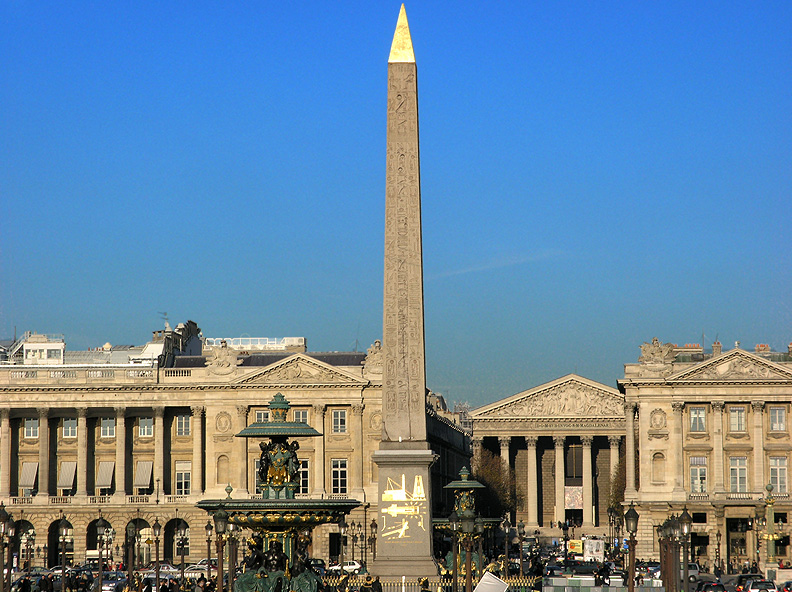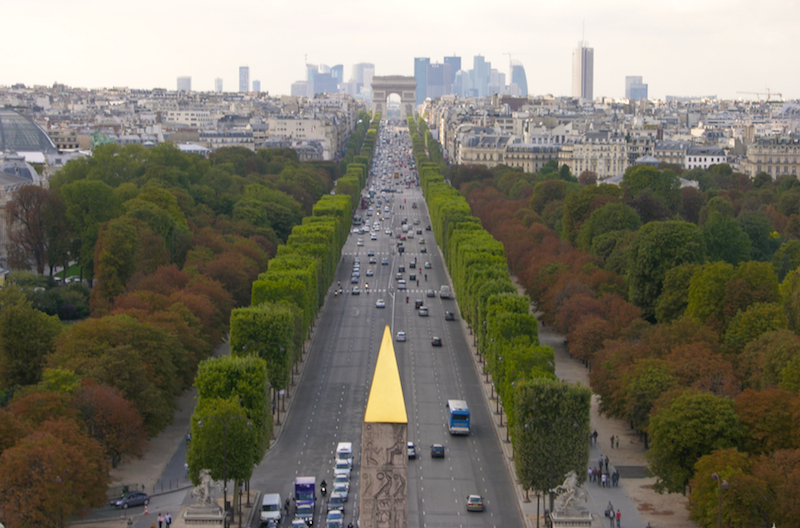
Axe Historique. Click image for full view.
Paris' Axe Historique is a shaft of space running east-west along the Champs Elysees. Few places are so steeped in the history of a country as this. The Louvre began as a medieval fortress on Right Bank of the River Seine, built by Philip II in the 12th century. West of the Louvre, the Place de la Concorde, originally named Place de Louis XV in 1755, was the site of over 1,000 public executions in the 18th century. These were initially execution of convicted criminals, and concluded with execution of royalty, previously spectators, during the French Revolution. Today this large square is centered on the Obelisque de Luxor, a 3,500-year-old Egyptian relic given to France in 1833.

Obelisque, at Place de la Concorde. This view is perpendicular to Axis, facing north.
The axis began as a vista to the west from the Louvre. Construction of the Champs-Elysees was, in effect, commissioned by Marie de Medici in 1616. Initially defined by rows of trees running parallel to its length, this avenue ran west through open fields from the Tuileries Palace toward the eventual location (1810-1833) of the Arc de Triomphe.

Champs-Elysees. 1890.
The Louvre, the older palace, is adjacent to the Tuileries site, and survived the fire set by the Paris Commune that consumed Tuileries in 1871. After destruction of the Tuileries, its site was landscaped, becoming the Tuileries Garden. The Arc de Triomphe du Carrousel, a smaller version of Arc de Triomphe, is located on the axis between the former Tuileries Palace site and the Louvre.
_-_%27Morning,_Winter_Sunshine,_Frost,_the_Pont-Neuf,_the_Seine,_the_Louvre,_Soleil_D%27hiver_Gella_Blanc%27,_ca__1901.jpg)
Camille Pissaro. Morning, Winter Sunshine, Frost, the Pont-Neuf,
the Seine, the Louvre, Soliel D'hiver Gella Blanc. 1901.
So, the arrangement of the Axe Historique was cast, with the Louvre at the east end, the Arc de Triomphe at the west.

Facing east from the Arc de Triomphe.
Paris' Axe Historique is a shaft of space running east-west along the Champs Elysees. Few places are so steeped in the history of a country as this. The Louvre began as a medieval fortress on Right Bank of the River Seine, built by Philip II in the 12th century. West of the Louvre, the Place de la Concorde, originally named Place de Louis XV in 1755, was the site of over 1,000 public executions in the 18th century. These were initially execution of convicted criminals, and concluded with execution of royalty, previously spectators, during the French Revolution. Today this large square is centered on the Obelisque de Luxor, a 3,500-year-old Egyptian relic given to France in 1833.

Obelisque, at Place de la Concorde. This view is perpendicular to Axis, facing north.
The axis began as a vista to the west from the Louvre. Construction of the Champs-Elysees was, in effect, commissioned by Marie de Medici in 1616. Initially defined by rows of trees running parallel to its length, this avenue ran west through open fields from the Tuileries Palace toward the eventual location (1810-1833) of the Arc de Triomphe.

Champs-Elysees. 1890.
The Louvre, the older palace, is adjacent to the Tuileries site, and survived the fire set by the Paris Commune that consumed Tuileries in 1871. After destruction of the Tuileries, its site was landscaped, becoming the Tuileries Garden. The Arc de Triomphe du Carrousel, a smaller version of Arc de Triomphe, is located on the axis between the former Tuileries Palace site and the Louvre.
_-_%27Morning,_Winter_Sunshine,_Frost,_the_Pont-Neuf,_the_Seine,_the_Louvre,_Soleil_D%27hiver_Gella_Blanc%27,_ca__1901.jpg)
Camille Pissaro. Morning, Winter Sunshine, Frost, the Pont-Neuf,
the Seine, the Louvre, Soliel D'hiver Gella Blanc. 1901.
So, the arrangement of the Axe Historique was cast, with the Louvre at the east end, the Arc de Triomphe at the west.

Facing east from the Arc de Triomphe.
The Champs-Elysees quickly began to develop with shops, homes and offices behind its defining rows of trees. After the French Revolution in 1789 and the end of monarchy, the Louvre was officially designated a museum in 1793. It had functioned as a museum for a hundred years, since Philip moved the household to Versailles. As the east end of the Axis, the historic, prominent site has been nurtured and carefully expanded over the years, now containing over 650,000 square feet.

Facing west. Oblisque in foreground, Arc de Triomphe beyond. La Defense on the horizon.
This monumental construct of national pride is the definition of pomp. The Axe Historique might be too vast and ostentatious to be enjoyable, were it not for the context of its intentions, its intricate, fascinating history and the charm of all its adjacent streets, the river and interconnecting places. As it is, this primary space of what is widely considered the world's most beautiful capital seems fitting and properly scaled for its nature. It's truly magnificent.
Below, Current photo of the Louvre at dusk. I.M.Pei's pyramid. Wiki.
As all images this post, please click on image for full view.

Link: Thomas Mayer's photos of the Louvre Pyramid.

No comments:
Post a Comment